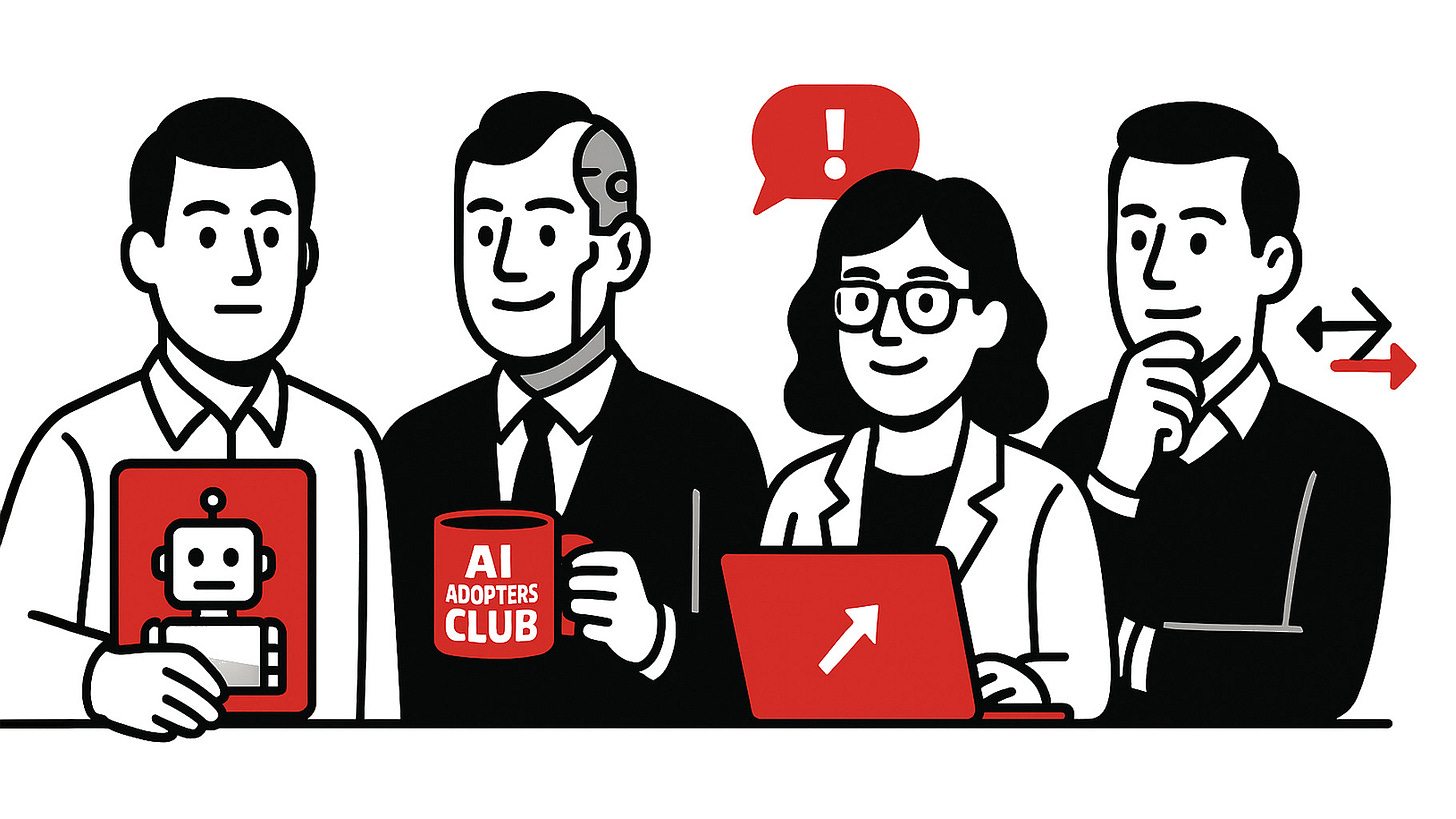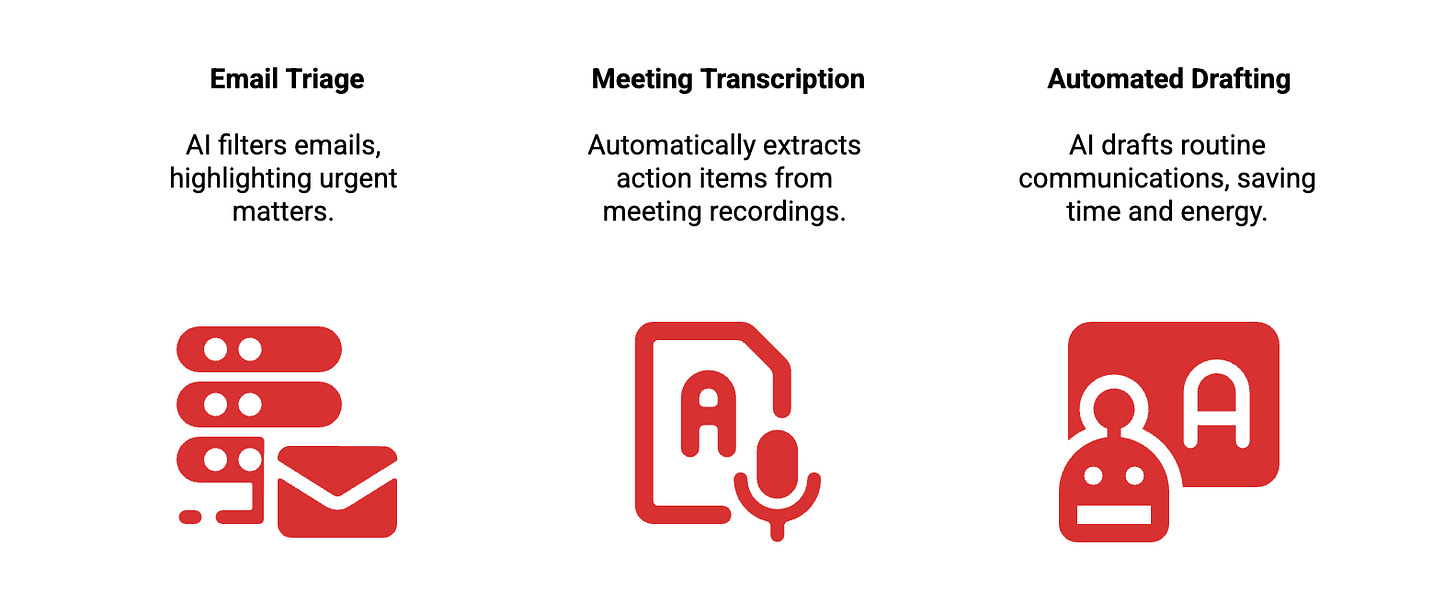The Augmented Executive
Why modern leaders are quietly using AI as a force multiplier
Hey Adopter,
Last week, I sat down with five C-suite executives from different industries who all asked me the same question: "How do we get our leadership teams to actually use AI?"
Not just talk about it. Not just delegate it. But personally leverage it to become sharper, faster, and more strategic.
What I'm about to share isn't another AI cheerleading session. It's a practical breakdown of how forward-thinking executives are already using AI as their secret weapon, based on comprehensive research into AI-enhanced leadership across major organizations.
The Cognitive Load Problem No One Talks About
Here's a stark reality: Research shows chronic stress reduces frontal lobe efficiency by up to 30%, directly impairing executive decision-making, according to Agave Health's analysis.
This isn't just about feeling tired. It's about your brain's literal capacity to process complex information and make good decisions. And it's getting worse. A recent Oracle study found that 85% of business leaders experience "decision stress," with 75% saying the number of daily decisions has increased tenfold over three years, as reported by Harvard Business Review researchers Purdy & Williams.
Smart executives aren't just powering through this. They're outsourcing mental load to AI, creating what Microsoft's Aparna Chennapragada calls a "cognitive energy surplus".
In practice, this looks like:
One Fortune 500 chief of staff described this shift as moving from "doing everything yourself" to having a "digital team that captures information and drafts content so the executive's mind is freed for big-picture thinking."
Why Your Strategic "Gut Feel" Needs an AI Partner
Let's be brutally honest: your intuition has blind spots, no matter how experienced you are.
Research has identified over 180 cognitive biases affecting decision-making. What is the most dangerous for leaders? Confirmation bias and the Dunning-Kruger effect. You seek information that confirms what you already believe, and you likely overestimate your expertise in certain areas.
AI won't replace your intuition, but it can dramatically enhance it. Take the tech CEO who, before finalizing a product pivot, ran her strategy through an AI analysis. The response was "brutal but eye-opening," surfacing overlooked market trends and team feedback that she'd missed or dismissed.
The leadership advantage here isn't just having more data. It's about:
Having an AI "telescope" that spots weak signals and emerging patterns long before humans can
Applying pattern recognition across millions of data points rather than your limited experience set
Generating "what if" scenarios to stress-test strategic assumptions
According to McKinsey research, companies that build decisions on data/analytics are 19 times more likely to be profitable than those relying primarily on gut instinct. The evidence isn't subtle.
The Four AI Leadership Archetypes
How leaders integrate AI into their work reveals distinct patterns that amplify their existing leadership style:
The Automator: Focuses relentlessly on efficiency. Implements AI bots for scheduling, data entry, and customer service to free humans from repetitive tasks. At their best, they create highly productive teams. At worst, they risk treating complex human problems as engineering challenges.
The Advisor: Uses AI as a trusted consigliere, regularly consulting it for strategic advice, analysis, and creative input. They're excellent at reducing personal bias by routinely getting a second opinion. The risk? Becoming over-reliant on AI input, potentially dulling their own instincts.
The Democratizer: Pushes AI tools to their entire team, believing in "AI for everyone." They flatten decision hierarchies by equipping junior staff with AI insights. This builds an innovation culture but can lead to inconsistency without proper guidelines. Transparency and training are essential here.
The Synthesizer: Excels at combining AI insights with human judgment. Neither outsources decisions fully to AI nor ignores its recommendations. Instead, they blend multiple inputs, using AI to challenge and refine thinking. The challenge is avoiding analysis paralysis with so many inputs.
Most executives blend these archetypes, but understanding your dominant style helps identify potential blind spots. As leadership advisor Fabio Moioli noted, "AI in leadership is a multiplier. It will amplify your strengths rather than magnify weaknesses, but only if leadership realigns fundamental strategies."
Using AI as Your Strategic Mirror
The most fascinating impact of AI on leadership isn't automation. It's reflection.
Forward-thinking executives are using large language models as "Socratic assistants" that pose tough questions without hierarchical fear. The AI doesn't have political concerns or career ambitions, so it can surface issues human employees might hesitate to voice.
Practical prompts smart leaders are using include:
One tech founder described this as having "a really well-read intern who isn't afraid to tell me I might be wrong," according to PowerHub's leadership research.
The value isn't always in the AI's answers. Sometimes it's in the questions the process forces you to articulate. As one consulting firm noted, "AI isn't a magic 8-ball for decisions, but it can force you to articulate 'Why do I believe this?' and that exercise alone makes strategies stronger."
AI Literacy + Emotional Intelligence
As AI handles more analytics, emotional intelligence becomes even more crucial for leaders. The twist? AI literacy is fast becoming intertwined with emotional intelligence as a core leadership competency.
Leaders must not only understand AI tools, but also manage the human side of AI integration:
Empathetically explaining how AI-driven feedback was generated
Contextualizing AI outputs with personal coaching and human judgment
Creating a psychologically safe environment where employees can question AI outputs
Research involving 600+ employees across multiple industries found that while people already have more confidence in AI than their human bosses for certain tasks, they continue to value human connection and empathy from leaders.
A Gartner report predicts that by 2026, empathy will be among the top skills CEOs seek to develop, precisely because it's the counterweight to an AI-heavy workplace.
The Trust Factor: How to Communicate AI-Supported Decisions
When leaders leverage AI for decisions, Harvard Business Review researcher David De Cremer bluntly states, "Employees won't trust AI if they don't trust their leaders."
Trust erodes when AI decisions are presented as black-box mandates. It grows when leaders:
Position AI as a teammate, not the boss: Frame AI as decision-support rather than the decision-maker. HireVue's 2025 Global AI report noted a 53% increase in trust in AI-driven hiring when AI was clearly presented as assisting human judgment rather than replacing it.
Explain the logic in plain language: Don't just announce decisions. Share a simple narrative about what data the AI analyzed and how you validated or modified its recommendations.
Maintain open dialogue: When teams know AI influenced a decision, transparent leaders invite questions: How did we ensure the AI's recommendation was fair? What checks were in place?
As one HBR analyst put it, "AI's presence in decision-making is a test of organizational trust. It will either erode or reinforce it, depending on how leaders handle it."
Building Your AI Inner Circle
Just as executives have trusted human advisors, savvy leaders are now assembling a personal "AI leadership circle" of specialized tools.
One tech CEO writing on LinkedIn shared his approach: "ChatGPT is my go-to brainstorming partner; Claude I use for refining ideas or summarizing long texts; and Perplexity helps me fact-check and gather the latest info quickly."
The future vision is even more integrated. Microsoft's product chief recently discussed in a PYMNTS interview AI moving to a "third phase: a group of people and a group of AI agents working together," where a central AI acts as a "digital chief of staff" managing subsidiary specialist bots.
When selecting AI advisors, leaders should evaluate options based on:
Accuracy and reliability (has the AI been tested, does it have guardrails?)
Explainability (can it provide reasoning for its outputs?)
Security/privacy (does using this AI risk sensitive data leaks?)
Alignment with purpose (is the AI tuned for your specific need?)
The Ethics of Amplified Power
AI gives leaders unprecedented power to make decisions faster, with deeper insight, and at greater scale. This amplification demands heightened ethical awareness.
The biggest flashpoint is AI-driven surveillance. While monitoring can yield efficiency gains, a Cornell University study highlighted that employees subjected to extensive AI monitoring felt significantly less trusted and showed more resistance and turnover.
As reported in SHRM's research on AI surveillance, Cisco's CEO famously stated they chose not to monitor keystrokes because "just because the technology exists doesn't mean we should use it... we choose trust." This captures an essential ethical stance: restraint in the use of power is a virtue.
Other ethical considerations include:
Avoiding bias amplification in AI-supported decisions
Balancing decision velocity with necessary deliberation
Preserving employee autonomy while benefiting from AI efficiency
The augmented executive must also be the ethical executive, keenly aware that more power requires more restraint.
Your Next Steps
If this has sparked your interest in becoming an AI-enhanced leader, start with these practical actions:
Audit your cognitive load: Identify where mental bandwidth gets wasted on low-value decisions or information processing that AI could handle
Test the mirror effect: Try using AI to critique one of your upcoming strategic decisions with specific prompts
Evaluate your leadership archetype: Which AI integration style sounds most like you, and what blind spots might that create?
Develop AI literacy alongside EQ: Focus on understanding not just what AI tools can do, but how to communicate about them with emotional intelligence
Adapt & Create,
Kamil







